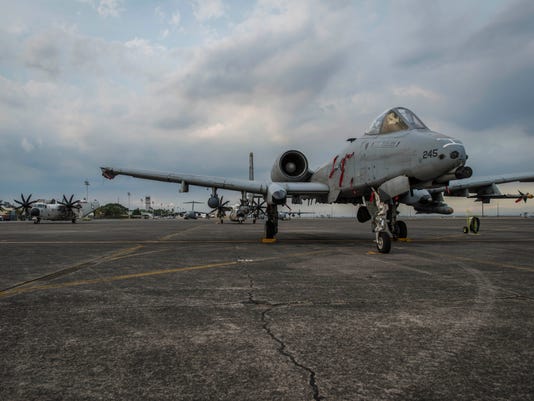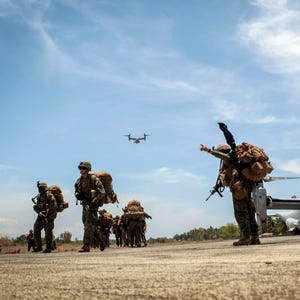
A U.S. Air Force A-10C Thunderbolt II with the 51st Fighter Wing, Osan Air Base, South Korea, sits on the flight line of Clark Air Base, Philippines, on April 16. The Air Force said the air contingent is there to support cooperation with Philippine forces, but experts say it's likely a move designed to counter China's territorial ambitions in the South China Sea as well.(Photo: SSgt. Benjamin Stratton/Air Force)
The move came just two days after Secretary of Defense Ash Carter and Philippine Defense Secretary Voltaire Gazmin announced an "enhanced military alliance" between the two countries in Manila.
The rotational force includes five A-10C Thunderbolt IIs from the 51st Fighter Wing at Osan Air Base, South Korea, and three HH-60G Pave Hawk helicopters with the 18th Air Wing out of Kadena Air Base, Japan, and more than 200 airmen from various Pacific Air Forces units. They include aircrew, maintainers, logisticians and support personnel.
About 175 airmen stayed in the Philippines to stand up the contingent following the annual Balikatan exercise, April 4-16, that involved more than 8,000 service members from the U.S, Philippines and Australia. Another 30 airmen will arrive from PACAF headquarters at Joint Base Pearl-Harbor-Hickam, Hawaii, as well as several other PACAF bases.
It is not yet clear how long the aircraft and airmen will remain at Clark, but future rotations are planned. The composition of those units has yet to be determined.
The Warthogs, Pave Hawks, and airmen will remain at Clark “as long as both the Philippines and the United States deem necessary,” Lt. Col. Damien Pickart, a PACAF spokesman, told Air Force Times.
“There are many other U.S. military and international assets that provide unique capabilities, and which may be considered to support the air contingent,” Pickart said. “At this time, it is too early to speculate what other type of aircraft may support this detachment, but we are not limiting our options to any one type.”
The Air Force group will be joining Navy P-8 Poseidon aircraft already at Clark, a hub of U.S. military air power until it was closed in 1991. It was reopened to U.S. forces in June 2012.
The service will carry out joint missions with the Philippine air forces focused on “maritime domain awareness, personnel recovery, combating piracy, and assuring access to the air and maritime domains in accordance with international law.”
As for the presence of the venerable Warthog, Pickart said the “A-10C was the right choice for this mission as it is capable of loitering close to the surface for extended periods to allow for excellent visibility over land and sea domains.”
The Air Force insists the move to set up a new air contingent is “not directed at any particular nation or military.”
“The Philippine and U.S. governments consult regularly on matters of mutual defense and military cooperation, and the status and activities of the air contingent will now be among those topics discussed,” Pickart said.
“The standup of this air contingent and the presence of our aircraft and personnel underscore the U.S. commitment to the Indo-Asia-Pacific region in an unpredictable and uncertain environment,” he continued.
But the move is likely to exacerbate tensions with the Chinese government, which has laid claim to the South China Sea, a large expanse of the Pacific Ocean encircled by the Chinese mainland, Taiwan, the Philippines, Malaysia and Vietnam.
China has constructed military bases and landing strips on artificially created reefs in the Spratly Islands, an area roughly 230 miles off the Philippine coast.
The U.S. has responded by sending Navy ships within 12 miles of these new islands, China's self-proclaimed territory, to reinforce its position that these are international waters and open to shipping. And the Air Force has started sending forces to the Philippines as well.
“If the Chinese show up and do something aggressive off the [Philippine] coast, we need something closer than Guam or Okinawa,” said Gregory Poling, an expert with the Center for Strategic and International Studies, a Washington, D.C., think-tank.
“You need to have them on forward position on the site of the conflict,” Poling told Air Force Times. “We need to have air assets forward deployed to respond to any crisis there. Taking off from Okinawa and refueling is not the ideal way to do that, and we can’t always have an aircraft carrier right next door.”
The 2014 Enhanced Defense Cooperation Agreement between the U.S. and the Philippines, allows the U.S. military to rotate troops into the island nation and build structures to support military operations.
“It is clearly there so that the U.S. can invest in infrastructure,” said Poling, director of CSIS’s Asian Maritime Transparency Initiative. "That’s all about boosting Philippine maritime awareness capabilities and our own [intelligence, surveillance and reconnaissance] capabilities.,” said Poling, the director of CSIS’s Asian Maritime Transparency Initiative.
The presence of U.S. troops and aircraft is likely to be viewed positively by other Southeast Asia nations.
“Other than the Chinese, I think everyone else is on the same page more or less,” he said. “The Philippines’ neighbors — Vietnam, Malaysia, Indonesia — they’re all facing a very aggressive China in the South China Sea. They’re happy to see an American presence. They might not want to host [troops] themselves, but they’re glad to see them in the region.:
Despite serving in part as a deterrent to Chinese moves in the region, Poling said the air contingent at Clark — and U.S. forces at other Philippine bases — will have a wide range of other missions.
In 2013, Typhoon Haiyan struck the Philippines, killing an estimated 6,300 people. U.S. military personnel were among the first to respond to the disaster and were critical in providing supplies and medical aid, Poling said. Having more U.S. forces in the Philippines will allow the U.S. to respond to such events even more quickly.
Leaders in the Philippines are also worried about potential terrorists in their nation and support for the Islamic State group.
“They’re getting increasingly concerned,” Poling said. “They’re still not as concerned as, say, the Indonesians are, given the Jakarta attack” in January that killed four and injured more than 20.
Abu Sayyaf militants were responsible for a 2004 terrorist attack in the Philippines that killed more than 100 people. The U.S. and Philippines worked together to target the group, and had “remarkable success” is dismantling most of their operations, Poling said, adding that the group has since devolved into more of a criminal organization focused on kidnapping for ransom.
However, at least one of the group’s leaders has declared allegiance to the Islamic State terrorists, raising the specter of future attacks.
“Neither country — the U.S. or the Philippines — has any interest in seeing them return to the kind of threat they were 10 or 15 years ago,” Poling said.


No comments:
Post a Comment
Note: Only a member of this blog may post a comment.